Jun 7, 2011
0
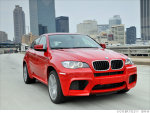
BMW X6
The X6 is marketed as a "sports activity coupe" that combines the attributes of an SUV (high ground clearance, all wheel drive large wheels and tires) with the stance of a coupé (bold styling, dramatic sloping roof). BMW sales are hot, but buyers are apparently confused by the concept, put off by the chunky styling, or deterred by the high price -- close to $100,000 for the turbocharged M version. So far this year, BMW has sold just 1,559 of them versus more than 10,000 of the more conventional X5.
Mercedes-Benz R-Class
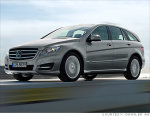 Similar woes have afflicted the Mercedes-Benz R-Class, first introduced in 2006. Essentially a low-roofed minivan with three rows of seats, it was initially marketed as a "sports cruiser." When that didn't fly, Mercedes tied on a more apropos "family tourer" moniker. Confused buyers, put off by the R's funereal looks, stayed away. U.S. sales never came within shouting distance of Mercedes' goal of 25,000 a year. Despite healthy incentives, the round-roofed R-Class has remained anchored to dealers' lots. A scant 195 found buyers during the month of April.
Similar woes have afflicted the Mercedes-Benz R-Class, first introduced in 2006. Essentially a low-roofed minivan with three rows of seats, it was initially marketed as a "sports cruiser." When that didn't fly, Mercedes tied on a more apropos "family tourer" moniker. Confused buyers, put off by the R's funereal looks, stayed away. U.S. sales never came within shouting distance of Mercedes' goal of 25,000 a year. Despite healthy incentives, the round-roofed R-Class has remained anchored to dealers' lots. A scant 195 found buyers during the month of April.
Ford Flex / Lincoln MKT
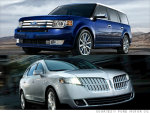 A valiant attempt to reinvent the minivan by emphasizing its horizontal proportions and flattening the roof, the Flex and its Lincoln sibling, arrived on the market in 2008, which turned out to be exactly the wrong time; consumers were looking for vehicles with less-exaggeratedly large proportions. Despite Ford's blossoming, the Flex found itself trailing the more conventional Chevy Traverse and Toyota Highlander in the showroom. Ford was expecting to sell 100,000 annually but has struggled to sell a third that many. So far in 2011, only about 2,000 Flexes are finding buyers each month.
A valiant attempt to reinvent the minivan by emphasizing its horizontal proportions and flattening the roof, the Flex and its Lincoln sibling, arrived on the market in 2008, which turned out to be exactly the wrong time; consumers were looking for vehicles with less-exaggeratedly large proportions. Despite Ford's blossoming, the Flex found itself trailing the more conventional Chevy Traverse and Toyota Highlander in the showroom. Ford was expecting to sell 100,000 annually but has struggled to sell a third that many. So far in 2011, only about 2,000 Flexes are finding buyers each month.
Smart Fortwo
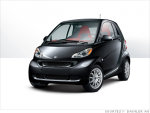 Smart is still trying to prove that a funny-looking two-seat car that is challenged at highway speeds and gets mediocre gas mileage will appeal to enough American buyers to constitute a business. Superdealer Roger Penske threw in the towel in February when he returned his exclusive distributor to corporate parent Mercedes-Benz. A new battery-powered version probably isn't going to charge up sales, which fell to 467 in April.
Smart is still trying to prove that a funny-looking two-seat car that is challenged at highway speeds and gets mediocre gas mileage will appeal to enough American buyers to constitute a business. Superdealer Roger Penske threw in the towel in February when he returned his exclusive distributor to corporate parent Mercedes-Benz. A new battery-powered version probably isn't going to charge up sales, which fell to 467 in April.
Toyota Tundra
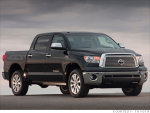 Toyota put all its brains and brawn behind the second generation Tundra that it launched in 2006, surveying buyers for wanted features and building a dedicated assembly plant in San Antonio. For all that, it has been unable to convince Ford and Chevy truck owners to switch. The recession and Toyota's recall crisis haven't helped. The Texas plant has the capacity to build 200,000 trucks a year, but Toyota only sold 93,309 in 2010. Sales look a little better this year, but Tundra is in no danger of dethroning the F-150 or Chevy Silverado.
Toyota put all its brains and brawn behind the second generation Tundra that it launched in 2006, surveying buyers for wanted features and building a dedicated assembly plant in San Antonio. For all that, it has been unable to convince Ford and Chevy truck owners to switch. The recession and Toyota's recall crisis haven't helped. The Texas plant has the capacity to build 200,000 trucks a year, but Toyota only sold 93,309 in 2010. Sales look a little better this year, but Tundra is in no danger of dethroning the F-150 or Chevy Silverado.
Nissan Quest
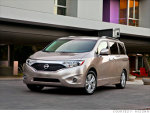 Nissan's fourth attempt at cracking the minivan equation was supposed to close the gap with the Big Three: Chrysler, Honda, and Toyota. No such luck. Nissan has sold just 3,335 Quests this year, while Honda has rolled out 36,306 Odysseys. Blame it on 1) the decision to sit out the 2010 model year; 2) the fact that Nissan is far down the shopping list for minivan buyers; and 3) a design that looks big on the outside but is small on the inside. Will Nissan follow GM and Ford in exiting the minivan business? Stay tuned.
Nissan's fourth attempt at cracking the minivan equation was supposed to close the gap with the Big Three: Chrysler, Honda, and Toyota. No such luck. Nissan has sold just 3,335 Quests this year, while Honda has rolled out 36,306 Odysseys. Blame it on 1) the decision to sit out the 2010 model year; 2) the fact that Nissan is far down the shopping list for minivan buyers; and 3) a design that looks big on the outside but is small on the inside. Will Nissan follow GM and Ford in exiting the minivan business? Stay tuned.
Maybach
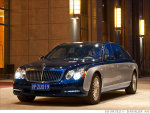 Maybach was launched with a flourish in 2002 when a helicopter plucked the first one off the deck of the Queen Elizabeth 2 in New York harbor and deposited it on the dock. Nine years later, the QE2 has managed to avoid the scrap yard, but Maybach may not be so fortunate. To compete with an all-new Rolls-Royce and Bentley, Mercedes-Benz rushed out two re-bodied S-Class cars, christened them with an historic German car brand, and priced them in the stratosphere -- upwards of $400,000. Even the super-rich could see through the sheet metal. A mere 20 Maybachs have found buyers this year.
Maybach was launched with a flourish in 2002 when a helicopter plucked the first one off the deck of the Queen Elizabeth 2 in New York harbor and deposited it on the dock. Nine years later, the QE2 has managed to avoid the scrap yard, but Maybach may not be so fortunate. To compete with an all-new Rolls-Royce and Bentley, Mercedes-Benz rushed out two re-bodied S-Class cars, christened them with an historic German car brand, and priced them in the stratosphere -- upwards of $400,000. Even the super-rich could see through the sheet metal. A mere 20 Maybachs have found buyers this year.
Honda Insight
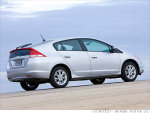 The Insight went on sale in March 2009 in the U.S as a 2010 model with prices starting at $19,800, making it the least expensive hybrid vehicle available in the United States. That should have boosted sales but didn't. Blame part of it on a drop in gasoline prices of over one-third over the past year that eroded demand for fuel-efficient cars. Blame the rest on excessive enthusiasm for cost-cutting. Embarrassingly for Honda, the more expensive Prius continues to beat Insight like a drum, outselling the Insight seven to one.
The Insight went on sale in March 2009 in the U.S as a 2010 model with prices starting at $19,800, making it the least expensive hybrid vehicle available in the United States. That should have boosted sales but didn't. Blame part of it on a drop in gasoline prices of over one-third over the past year that eroded demand for fuel-efficient cars. Blame the rest on excessive enthusiasm for cost-cutting. Embarrassingly for Honda, the more expensive Prius continues to beat Insight like a drum, outselling the Insight seven to one.
Acura ZDX
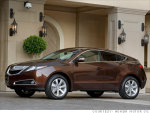 Instead of producing "a new level of prestige for Acura," as promised, the ZDX has produced a new, and wholly unwanted, level of exclusivity. Although it is based on the Honda Pilot crossover, Acura decided to market the ZDX as a "luxury four-door sports coupe," thereby throwing customers a curve ball. That, combined with styling that could politely be described as controversial -- as well as the overall malaise afflicting the Acura -- combined to sink the ZDX. Sales never got out of the batter's box, and fewer than 1,000 have found buyers this year.
Instead of producing "a new level of prestige for Acura," as promised, the ZDX has produced a new, and wholly unwanted, level of exclusivity. Although it is based on the Honda Pilot crossover, Acura decided to market the ZDX as a "luxury four-door sports coupe," thereby throwing customers a curve ball. That, combined with styling that could politely be described as controversial -- as well as the overall malaise afflicting the Acura -- combined to sink the ZDX. Sales never got out of the batter's box, and fewer than 1,000 have found buyers this year.
Subaru Tribeca
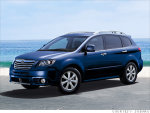 Usually conservative Subaru decided to show a little leg in 2005, when it introduced a new design language on the B9 Tribeca. Customers did not warm to the rounded body shape and odd triangular grille, and the Tribeca became the ugly duckling of the Subaru line. Quickly realizing its mistake, Subaru dropped "B9" from the name and abandoned the new look faster than you can say "Fuji Heavy Industries," but it was too late to save the Tribeca. With only 910 sold through April, it is rumored to be headed for extinction.
Usually conservative Subaru decided to show a little leg in 2005, when it introduced a new design language on the B9 Tribeca. Customers did not warm to the rounded body shape and odd triangular grille, and the Tribeca became the ugly duckling of the Subaru line. Quickly realizing its mistake, Subaru dropped "B9" from the name and abandoned the new look faster than you can say "Fuji Heavy Industries," but it was too late to save the Tribeca. With only 910 sold through April, it is rumored to be headed for extinction.
This information is extracted from Yahoo site
10 diappointed Cars in 2011

BMW X6
The X6 is marketed as a "sports activity coupe" that combines the attributes of an SUV (high ground clearance, all wheel drive large wheels and tires) with the stance of a coupé (bold styling, dramatic sloping roof). BMW sales are hot, but buyers are apparently confused by the concept, put off by the chunky styling, or deterred by the high price -- close to $100,000 for the turbocharged M version. So far this year, BMW has sold just 1,559 of them versus more than 10,000 of the more conventional X5.
Mercedes-Benz R-Class

Ford Flex / Lincoln MKT

Smart Fortwo

Toyota Tundra

Nissan Quest

Maybach

Honda Insight

Acura ZDX

Subaru Tribeca

This information is extracted from Yahoo site
Subscribe to:
Post Comments (Atom)


0 Responses to “10 diappointed Cars in 2011”
Post a Comment
Leave your comment here if you have any comment or want to share your idea.... I really appreciate all your comments.